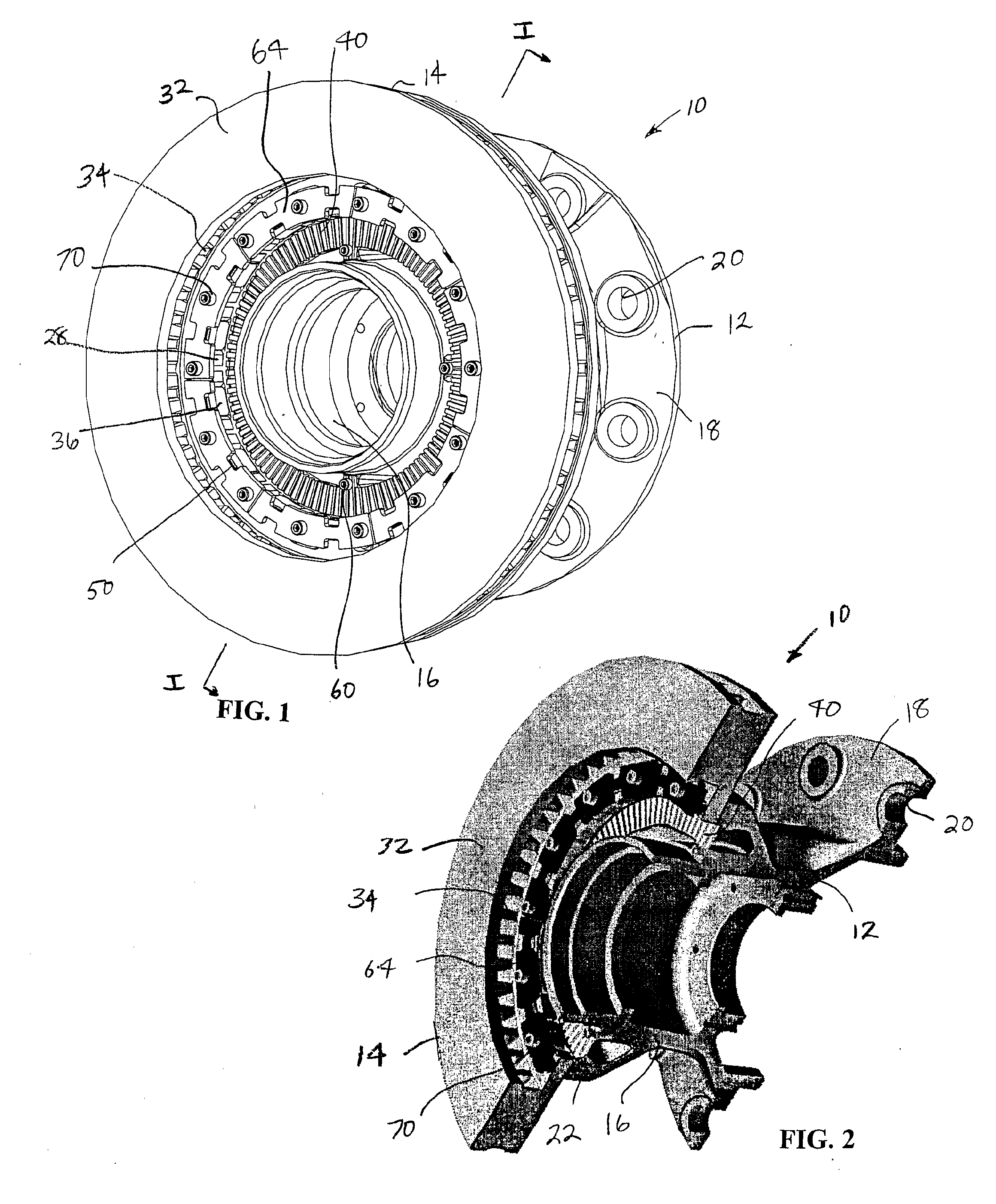Brake rotor and abs tone ring attachment assembly that promotes in plane uniform torque transfer distribution
a technology of torque transfer and rotor, which is applied in the direction of braking discs, braking systems, transportation and packaging, etc., can solve the problems of thermal distortion of the rotor, replacement of the entire integrated assembly, and high cost and time consumption
- Summary
- Abstract
- Description
- Claims
- Application Information
AI Technical Summary
Benefits of technology
Problems solved by technology
Method used
Image
Examples
first embodiment
[0054]FIG. 1 shows a brake rotor assembly 10 in accordance with the invention. The assembly 10 includes a hub 12 that supports a rotor 14. The hub 12, as used herein, can be a wheel hub, a rotating flange, a bearing housing of a hub assembly or the hat portion of an integrated rotor. The term hub in this application is intended to cover all known possible mountings for a rotor.
[0055]The hub 12, seen in detail in FIGS. 3, 4, and 5, includes an axial body in the form of a central cylinder 16 with a radial mounting flange 18 on one end having a plurality of mounting apertures 20 therein and a rotor support flange 22 on the other end. The rotor support flange 22 extends outwardly from cylinder 16 and has an outward end that is radially spaced from the central cylinder 16. A series of axially extending threaded bores 21 are located on the central cylinder 16 in the space between the cylinder 16 and the flange 22. The outward end of the rotor support flange 22 is an annular ring that exte...
second embodiment
[0067]A second embodiment is shown in FIGS. 19-29, with FIG. 26 showing the entire assembly 100. In this embodiment, the tone ring and the top plate are formed as one structure to reduce the number of components needed and to simplify assembly. Referring to FIGS. 19-21, the difference between the hub 12 and the modified hub 102 is the rotor mounting flange. Hub 102 has a central cylinder 104 with a radial mounting flange 106 on one end having a plurality of mounting apertures 108 therein and a rotor support flange 110 on the other end. The rotor support flange 110 is spaced from the central cylinder 104. The rotor support flange 110 is an annular ring that extends around the central cylinder 104 with a series of spaced threaded apertures 112 and presents a radial face for mounting the rotor 14 thereon. An inner raised lip 114 is provided on the inner periphery of the flange 110. The same rotor 14 shown in FIG. 7 is used with this embodiment.
[0068]As seen in FIG. 22, the rotor 14 is ...
PUM
 Login to View More
Login to View More Abstract
Description
Claims
Application Information
 Login to View More
Login to View More - R&D
- Intellectual Property
- Life Sciences
- Materials
- Tech Scout
- Unparalleled Data Quality
- Higher Quality Content
- 60% Fewer Hallucinations
Browse by: Latest US Patents, China's latest patents, Technical Efficacy Thesaurus, Application Domain, Technology Topic, Popular Technical Reports.
© 2025 PatSnap. All rights reserved.Legal|Privacy policy|Modern Slavery Act Transparency Statement|Sitemap|About US| Contact US: help@patsnap.com



